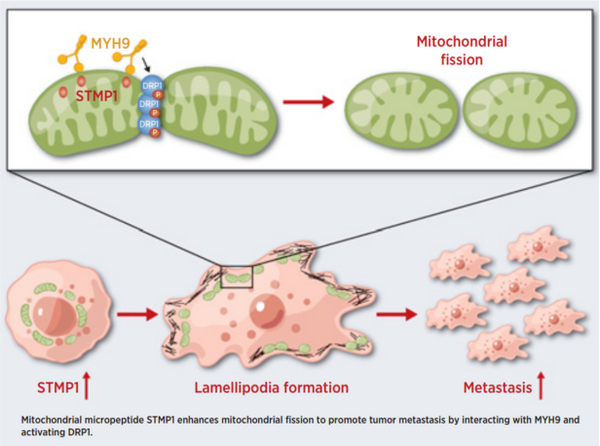A large number of small open reading frames (sORFs) are predicted to exist in the transcripts previously annotated as non-coding RNAs or untranslated regions of protein-coding genes. Emerging evidence show that sORFs may encode micropeptides with less than 100 amino acids. To date, only a small fraction of the putative micropeptides has been functionally characterized. More extensive investigations are necessary to identify new micropeptides and characterize their functions and regulatory networks. Prof. Shi-Mei Zhuang's team from Sun Yat-sen University has made a series of progresses in characterizing functional micropeptides using both in vitro and in vivo models. They discovered the important role of MPM, a mitochondrial micropeptide, in muscle differentiation (Cell Death & Dis. 2019) and liver cancer metastasis (Mol Ther. 2022). Moreover, they also revealed the function of another mitochondrial micropeptide, STMP1, in the cell cycle regulation of cancer cells (Mol Ther. 2022).
Mitochondria are organelles that work as cell powerhouses and are therefore critical for various cellular activities, including growth, apoptosis and mobility. Their functions are dynamically controlled by the balance between fusion and fission of the mitochondrial network. It has been shown that defects in either mitochondrial fusion or fission lead to mitochondrial dysfunction and are associated with diseases, including cancer. The critical step of fission is the recruitment of dynamin-related protein 1 (DRP1) from the cytoplasm to the outer mitochondrial membrane, where it binds fission 1 (FIS1) and mitochondrial fission factor (MFF). So far, the mechanisms controlling DRP1 recruitment and activation are not fully understood. In addition, whether proteins in the inner mitochondrial membrane are involved in the DRP1-induced fission process is still unknown in this field.
Recently, the team of Dr. Jian-Hong Fang & Prof. Shi-Mei Zhuang published a research paper entitled "Mitochondrial micropeptide STMP1 enhances mitochondrial fission to promote tumor metastasis" in the internationally renowned journal Cancer Research. They identified the inner-mitochondrial-membrane localized STMP1 as a novel unit of the mitochondrial fission protein machinery and a critical metastasis regulator.
This study showed that STMP1 was upregulated in various cancer types and associated with metastasis potential. STMP1 promoted mitochondrial fission by activating DRP1 and then enhanced the migration of tumor cells. Further studies showed that STMP1-induced mitochondrial fission resulted in mitochondrion redistribution to the leading edge of cells and enhanced lamellipodia formation. Treatment with DRP1 inhibitor abrogated the promotive effect of STMP1 in tumor metastasis in vitro and in vivo. Mechanistically, STMP1 interacted with myosin heavy chain 9 (MYH9), the subunit of non-muscle myosin II, and thus induced DRP1 phosphorylation and activation. This study identifies the stimulatory roles of STMP1 in mitochondrial fission and tumor metastasis, which discloses the underlying mechanism of enhanced mitochondrial fission in cancer and provides an attractive therapeutic target for anti-metastasis therapy.

Mitochondrial micropeptide STMP1 enhances mitochondrial fission to promote tumor metastasis by interacting with MYH9 and activating DRP1
Dr. Chen Xie and Feng-Yi Wang are the co-first authors. Associate Professor Fang-Jian Hong and Professor Shi-Mei Zhuang are the co-corresponding authors. School of Life Sciences, Sun Yat-sen University is the first communication affiliation. This work was supported by grants from the National Key R&D Program of China, National Natural Science Foundation of China, Science and Information Technology Bureau of Guangzhou, China Postdoctoral Science Foundation, Guangdong Basic and Applied Basic Research Foundation and Fundamental Research Funds for the Central Universities.
Link to the article:
https://aacrjournals.org/cancerres/article-abstract/82/13/2431/705035/Mitochondrial-Micropeptide-STMP1-Enhances?redirectedFrom=fulltext



